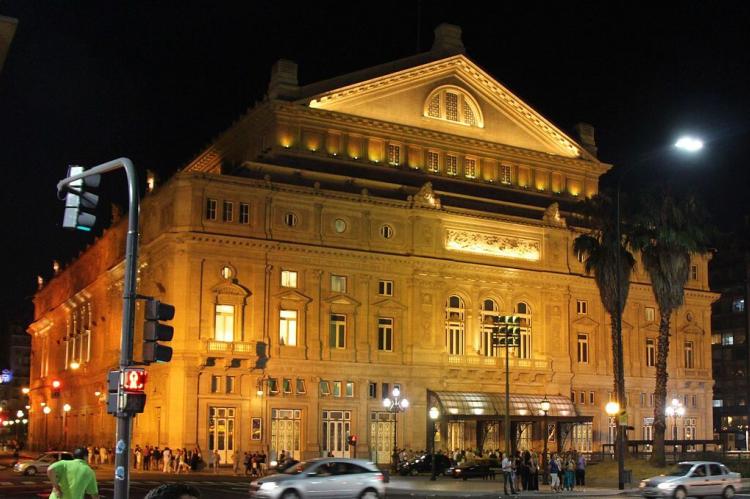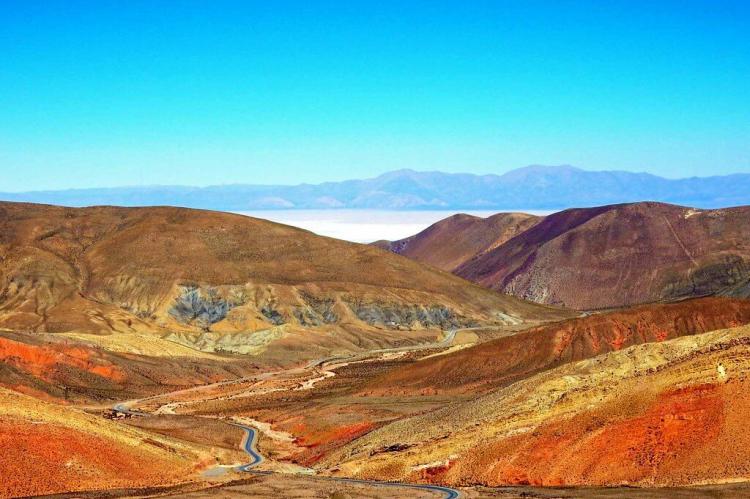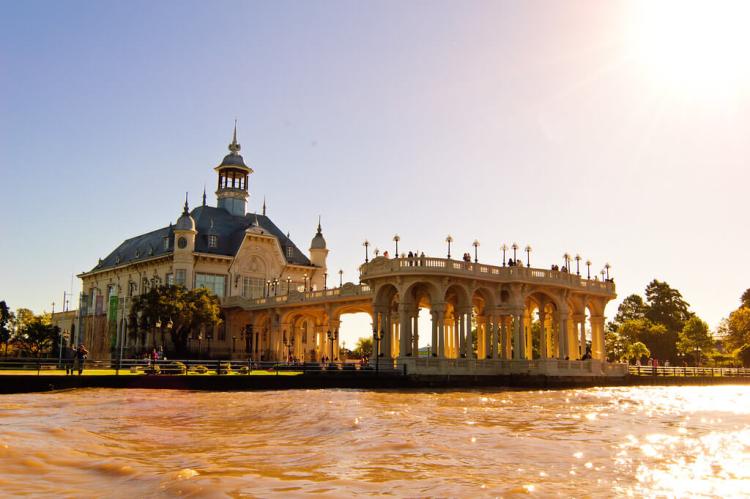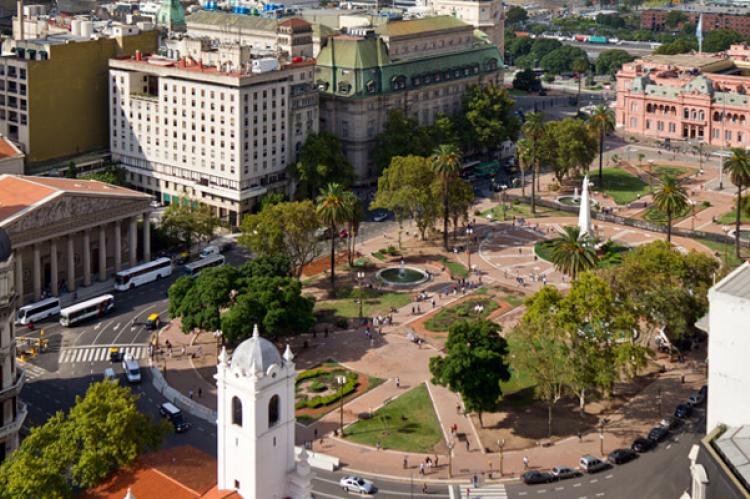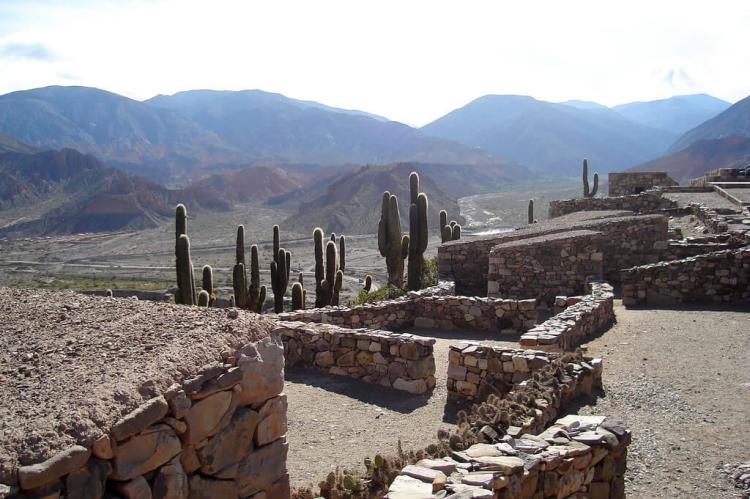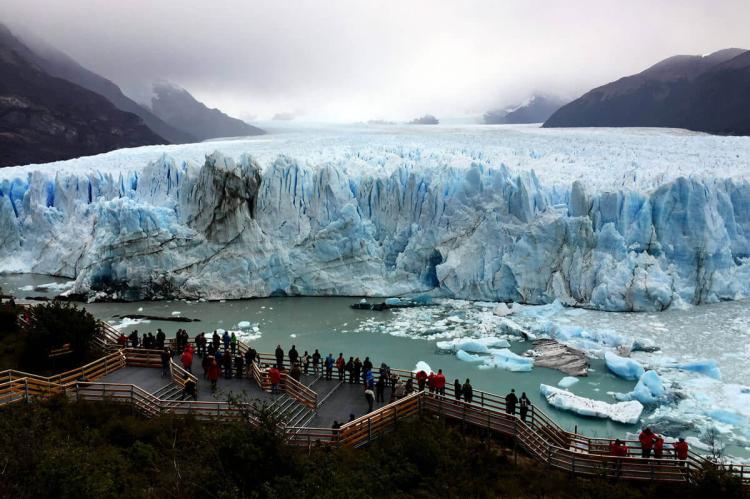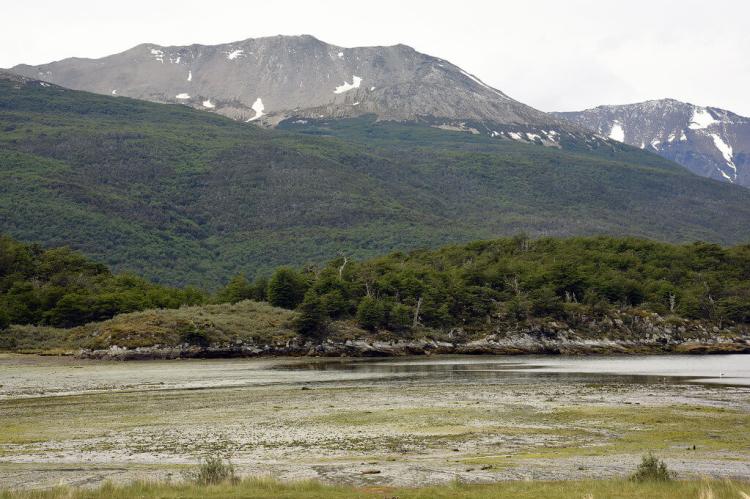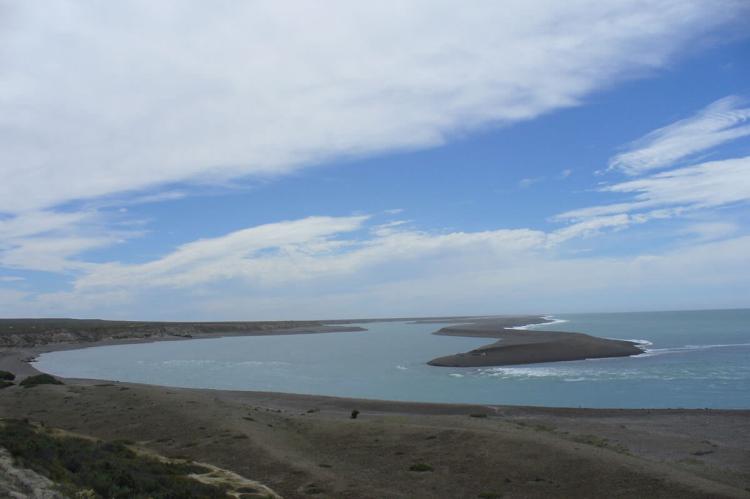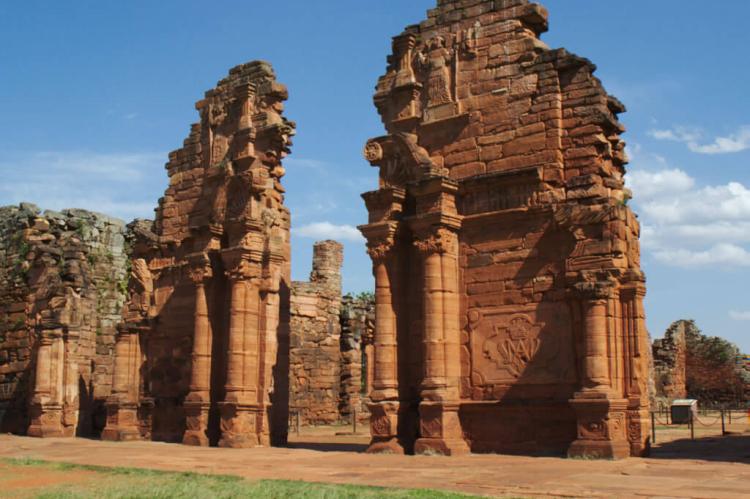Argentina: Cultural Landscape
Argentina's cultural landscape is shaped by geography, Indigenous heritage, European immigration, and history. From the subtropical north to the subantarctic south, this vast nation nurtures cultural expressions reflecting European influence and South American innovation.
The Cultural Landscape of Argentina: Tango, Tradition, and Transformation
Argentina's cultural landscape stands as one of the most complex and fascinating in Latin America, shaped by its vast geography, rich Indigenous heritage, massive European immigration, and unique historical trajectory. Spanning from the subtropical north to the subantarctic south, from the Andes Mountains to the Atlantic Ocean, this enormous nation has fostered cultural expressions that reflect both profound European influence and distinctly South American innovation. Argentina's cultural identity emerges from the intersection of pre-Columbian civilizations, Spanish colonialism, massive waves of European immigration, and contemporary global engagement, creating a society that is simultaneously cosmopolitan and deeply rooted in local traditions.
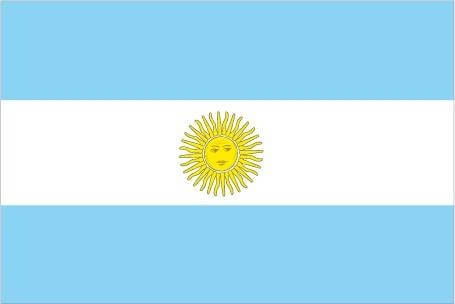
The official flag of Argentina.
Cultural Heritage: Foundations of Argentine Identity
Indigenous Foundations
Argentina's cultural heritage begins with its diverse Indigenous peoples, whose civilizations developed across the country's varied landscapes for millennia before the arrival of European contact. The northwest region was home to sophisticated civilizations influenced by the Inca Empire, including the Diaguita and Quilmes peoples, who developed advanced agricultural techniques, metallurgy, and artistic traditions that continue to influence regional culture today.
In the central Pampas region, nomadic peoples such as the Puelche and Tehuelche developed cultures that were adapted to the grasslands, emphasizing hunting, mobility, and complex social structures. Their knowledge of the land, particularly regarding cattle and horse culture, would prove instrumental in the development of gaucho traditions that became central to Argentine national identity.
The Mapuche people, whose territory extended from Chile across the Andes into Argentina, established powerful confederations that successfully resisted Spanish and later Argentine control until the late 19th century. Their influence on Argentine culture encompasses contributions to the language, particularly in the form of place names and terms related to nature and geography, as well as textile traditions and concepts of social organization.
In the northeast, the Guaraní peoples developed complex agricultural societies and left a lasting linguistic influence that remains strong in provinces such as Misiones and Corrientes. The Guaraní language continues to be spoken by significant populations and has contributed numerous words to Argentine Spanish, particularly related to flora, fauna, and local customs.
The southern regions were inhabited by various Indigenous groups, including the Selk'nam (Ona) and Yahgan peoples of Tierra del Fuego, who developed unique cultures adapted to the harsh Patagonian environment. While European colonization and subsequent policies dramatically reduced Indigenous populations, their cultural contributions remain embedded in Argentine regional identities, place names, and traditional practices.
Spanish Colonial Legacy
The Spanish conquest, beginning with Juan Díaz de Solís's expedition in 1516 and Pedro de Mendoza's founding of Buenos Aires in 1536, introduced European cultural elements that would fundamentally reshape the region. However, unlike other Spanish colonies with major Indigenous population centers, much of what would become Argentina remained sparsely populated and economically peripheral during the colonial period.
The colonial experience established Spanish as the dominant language, Catholic Christianity as the prevailing religion, and European architectural and artistic traditions as cultural standards. However, Argentina's colonial period was characterized by regional diversity, with different areas developing distinct cultural patterns based on their economic functions, geographic conditions, and relationships with Indigenous peoples.
The northwest, connected to the wealthy mining regions of Peru through trade routes, developed a more typically Spanish colonial culture, characterized by baroque churches, colonial architecture, and hierarchical social structures. Cities like Salta, Tucumán, and Córdoba became important colonial centers, boasting universities, religious institutions, and a sophisticated urban culture.
The Pampas region, initially less economically important, developed a more diverse culture where Spanish settlers, often of modest means, interacted more extensively with Indigenous peoples. This interaction created the foundation for gaucho culture, which combined Spanish horsemanship and cattle-raising techniques with Indigenous knowledge of the land and animals.
The Rio de la Plata region, despite early setbacks, eventually became crucial due to its position as a trade gateway. Buenos Aires, refounded in 1580, gradually developed into a major port city that would become the entry point for both Spanish colonial influence and later European immigration.
The Gaucho Tradition and National Identity
The gaucho represents perhaps Argentina's most distinctive cultural contribution and serves as a central element of national identity. Emerging in the 17th and 18th centuries from the mixing of Spanish, Indigenous, and later African elements on the Pampas, the gaucho developed as a semi-nomadic cattle herder and horseman who embodied values of independence, skill, and adaptation to the vast grasslands.
Gaucho culture created distinctive traditions in music, literature, clothing, food, and social organization that continue to influence Argentine culture today. The payada (improvised musical duels), asado (barbecue) traditions, and mate (herbal tea) consumption all emerged from gaucho culture and became national practices. The gaucho's relationship with the horse, cattle, and the open range created a cultural archetype that represents Argentine values of independence, skill, and connection to the land.
Literature played a crucial role in mythologizing and preserving gaucho culture, particularly through works like José Hernández's "Martín Fierro" (1872-1879), which became Argentina's national epic poem. This literary tradition helped transform the gaucho from a marginal social figure into a symbol of Argentine national character and resistance to foreign influence.
Massive European Immigration (1880-1930)
Argentina experienced one of the world's largest immigration waves between 1880 and 1930, receiving approximately 6.6 million immigrants, primarily from Italy and Spain, as well as significant numbers from France, Germany, Poland, Russia, and other European countries. This immigration fundamentally transformed Argentine society, creating the demographic foundation for modern Argentine culture.
Italian immigration was particularly significant, with over 2 million Italians settling in Argentina. Italian influence is evident in Argentine Spanish, which incorporates numerous Italian words and intonation patterns, as well as in the country's cuisine, including traditions such as pasta, pizza, and ice cream. Additionally, Italian influence is reflected in Argentine architecture and cultural attitudes. Many Argentine families maintain Italian traditions and connections, creating a cultural identity that blends Argentine and Italian elements.
Spanish immigration, while numerically smaller than Italian, reinforced Hispanic cultural elements and brought regional Spanish traditions, particularly from Galicia and the Basque Country. These immigrants contributed to Argentine cuisine, architecture, and cultural practices while strengthening connections to Hispanic heritage.
Other European immigrant groups created distinct cultural enclaves that continue to influence Argentine culture. German immigrants, particularly in the northeast and Patagonia, established agricultural communities, educational institutions, and cultural organizations. Jewish immigration, primarily from Eastern Europe, created vibrant communities in Buenos Aires and other cities, making significant contributions to the intellectual, artistic, and commercial life of these areas.
French cultural influence, though numerically smaller, was particularly strong among Argentina's elite and in cultural institutions. French architectural styles, educational methods, and cultural preferences significantly influenced Buenos Aires's development into a cosmopolitan city that aspired to rival Paris in sophistication and cultural offerings.
African Heritage and Influence
Although often overlooked in discussions of Argentine culture, African heritage played an important role in early Argentine development. Enslaved Africans were brought to Argentina during the colonial period, particularly to Buenos Aires and the northwest provinces. African contributions to Argentine culture include musical traditions (particularly in the development of tango), religious practices (often syncretized with Catholic traditions), and cultural expressions that became incorporated into broader Argentine culture.
The candombe, a musical and dance tradition with African roots, was particularly important in Buenos Aires and contributed to the development of tango and other Argentine musical forms. While the visible African population in Argentina decreased significantly during the 19th century due to various factors, including warfare, disease, and immigration patterns, African cultural influences remained deeply embedded in Argentine music, dance, and popular culture.
Contemporary Cultural Influences
Literature and Intellectual Tradition
Argentina has developed one of Latin America's most distinguished literary traditions, producing internationally acclaimed writers who have shaped both national identity and the global literary landscape. The country's literary culture reflects its complex relationship with European traditions, national identity, and universal themes that transcend geographic boundaries.
Jorge Luis Borges stands as Argentina's most internationally recognized literary figure, whose innovative short stories and essays explore themes of infinity, reality, and knowledge, incorporating Argentine cultural elements and universal philosophical questions. Borges's work influenced writers worldwide while establishing Argentina as a major center of literary innovation.
Other significant Argentine writers include Julio Cortázar, whose experimental fiction explored surreal and psychological themes; Adolfo Bioy Casares, who collaborated with Borges and contributed to the development of science fiction and fantasy literature; and Ernesto Sabato, whose novels addressed existential and political themes in Argentine society.
Contemporary Argentine literature continues to evolve, with writers like Manuel Puig, Tomás Eloy Martínez, and Ricardo Piglia gaining international recognition for works that explore Argentine history, identity, and social transformation. The country's strong literary magazine tradition, prestigious literary prizes, and active publishing industry support continued literary development.
The Argentine intellectual tradition extends beyond literature to encompass philosophy, sociology, and political thought. Thinkers such as Domingo Faustino Sarmiento, José Ingenieros, and Ezequiel Martínez Estrada made significant contributions to Latin American intellectual development, addressing specifically Argentine concerns about civilization, barbarism, and national identity.
Music and Dance: From Tango to Rock Nacional
Argentine music represents one of the country's most distinctive and internationally recognized cultural contributions. Tango, which emerged in Buenos Aires in the late 19th century from a mixture of African, European, and local influences, became not only Argentina's signature musical form but also a global cultural phenomenon.
Tango developed in the working-class neighborhoods of Buenos Aires, particularly in areas with high immigrant populations. The music combined elements of African candombe, European salon music, and local folk traditions to create a unique sound that expressed the urban experience of immigration, longing, and social transformation. Tango's evolution from marginal entertainment to respectable art form parallels Argentina's cultural development and search for international recognition.
Beyond tango, Argentina has developed a rich tradition of folk music that reflects its regional diversity and cultural heritage. The zamba, chacarera, cueca, and other folk forms maintain connections to both Indigenous and colonial traditions, serving as expressions of regional identity. The nueva canción movement of the 1960s and 1970s used folk music forms to address social and political themes, creating music that was both culturally rooted and politically engaged.
Rock nacional emerged in the 1960s as Argentine musicians adapted rock and roll to local conditions and concerns. Bands like Soda Stereo, Charly García, and Fito Páez created music that addressed Argentine experiences while incorporating international influences. Rock Nacional became particularly important during the military dictatorship as a form of cultural resistance and youth expression.
Contemporary Argentine music continues to evolve, incorporating electronic music, hip-hop, cumbia, and other global genres while maintaining connections to traditional forms. The country's music festivals, venues, and recording industry support both conventional and innovative musical expressions.
Cinema and Visual Arts
Argentine cinema has achieved international recognition as one of Latin America's most sophisticated film industries. From early pioneers to contemporary directors, Argentine cinema has explored themes of national identity, social issues, and universal human experiences, while developing distinctive artistic approaches.
The "New Argentine Cinema" movement of the 1990s and 2000s garnered international attention for directors such as Luisa Bemberg, Adolfo Aristarain, and later Juan José Campanella, whose films explored Argentine society with artistic innovation and social awareness. Films addressing the military dictatorship, immigration, social inequality, and cultural identity have gained international recognition at film festivals worldwide.
Visual arts in Argentina encompass both traditional and contemporary expressions. The country's art museums, galleries, and cultural institutions support a diverse range of artistic practices, from Indigenous crafts to cutting-edge contemporary art. Buenos Aires's vibrant street art scene has gained international recognition, with murals and graffiti serving as forms of political expression and cultural commentary.
Traditional crafts, particularly those from the northwest provinces, incorporate both Indigenous and colonial techniques in textiles, ceramics, and metalwork. These traditions serve as both a means of cultural preservation and a source of economic activity for rural communities, while also influencing contemporary design and fashion.
Cuisine and Culinary Traditions
Argentine cuisine reflects the country's cultural diversity and agricultural abundance, creating a distinctive culinary identity that combines Indigenous ingredients, Spanish colonial traditions, and extensive European immigrant influences. The result is a cuisine that is both internationally recognizable and deeply rooted in local traditions and preferences.
Beef culture stands at the center of Argentine cuisine, reflecting the country's cattle-raising heritage and gaucho traditions. The asado (barbecue) represents not only a cooking method but also a social institution that brings families and communities together around shared meals. Argentine beef preparation techniques, cuts, and accompaniments have gained international recognition and are widely copied.
Italian immigration had a profound influence on Argentine cuisine, making pasta, pizza, and ice cream integral parts of the national diet. However, these dishes were adapted to local tastes and ingredients, creating distinctly Argentine versions of Italian classics. The tradition of Sunday family pasta meals reflects both Italian heritage and Argentine family values.
Spanish influence appears in dishes like empanadas, which vary by region and reflect local ingredients and preferences. Each province has developed its own empanada traditions, creating regional culinary identities within the broader national cuisine.
Other notable immigrant influences include German contributions, particularly in Patagonia, as well as French influences on fine dining and pastry traditions. Additionally, there are Middle Eastern contributions from Lebanese and Syrian immigrants. These diverse influences have been synthesized into a coherent Argentine culinary identity that maintains regional variations while establishing national preferences.
Wine production, particularly in Mendoza and other western provinces, has become both an important economic activity and a cultural expression. Argentine wine culture combines Spanish and Italian traditions with local adaptations to create wines that have gained international recognition, representing Argentine sophistication and agricultural skill.
Sports Culture and National Identity
Sports, particularly football (soccer), play crucial roles in Argentine culture and national identity. Argentina has produced some of the world's greatest football players, including Diego Maradona and Lionel Messi, and the national team's World Cup victories have created moments of intense national unity and pride.
Football culture in Argentina extends far beyond professional sports to encompass neighborhood clubs, youth development, and social organization. The passion and dedication surrounding football reflect broader Argentine cultural values of intensity, skill, and emotional expression. Football stadiums serve as spaces for cultural expression, social gathering, and the formation of identity.
Other sports also contribute to Argentine culture, including polo, which has achieved international dominance for Argentina, rugby, basketball, and tennis. These sports reflect both international influence and local adaptation, creating athletic traditions that represent Argentine excellence and competitive spirit.
Cultural Challenges in Contemporary Argentina
Economic Instability and Cultural Development
Argentina's recurring economic crises have created ongoing challenges for cultural development and preservation. Economic instability affects funding for cultural institutions, limits access to cultural events and education, and creates pressures that can lead to cultural brain drain as artists and intellectuals seek opportunities abroad.
However, economic challenges have also stimulated cultural creativity and innovation. Periods of economic difficulty have often coincided with the flowering of artistic expression, as artists and writers address social conditions and search for meaning during difficult times. The relationship between economic conditions and cultural production remains complex and ongoing.
Regional Inequality and Cultural Centralization
Argentina's extreme centralization in Buenos Aires creates tensions between the capital and the provinces that affect cultural development and expression. Buenos Aires concentrates the majority of cultural institutions, media organizations, publishing houses, and cultural industries, which may potentially limit cultural development in other regions.
Regional cultures, while maintaining distinct identities and traditions, often struggle for national recognition and support against the dominance of Buenos Aires-based cultural institutions. This centralization can lead to the marginalization of regional cultural expressions and the homogenization of national culture around the norms and preferences of Buenos Aires.
Efforts to decentralize cultural activities and support regional cultural development represent ongoing challenges that require both policy interventions and changes in cultural attitudes and practices.
Indigenous Rights and Cultural Recognition
Despite constitutional recognition and various government programs, Indigenous communities in Argentina continue to struggle for land rights, cultural recognition, and economic opportunities. The preservation of Indigenous languages, traditions, and cultural practices faces ongoing challenges as younger generations often adopt Spanish as their primary language and urban lifestyles.
Argentina's national narrative has historically emphasized European immigration and gaucho traditions while marginalizing Indigenous contributions to national culture. Recent efforts to incorporate Indigenous perspectives into education, media, and public policy reflect a growing recognition of Indigenous heritage; however, implementation remains incomplete and contested.
The challenge involves creating genuine multicultural inclusion that recognizes Indigenous peoples as contemporary communities with ongoing cultural contributions rather than treating Indigenous heritage as a historical artifact.
Globalization and Cultural Authenticity
Like many countries, Argentina faces challenges in maintaining cultural authenticity while engaging with global cultural trends. The influence of North American and European popular culture, transmitted through media, technology, and consumer goods, creates pressure on traditional cultural expressions and local cultural industries.
The challenge involves finding ways to participate in global cultural exchanges while preserving and developing distinctly Argentine cultural expressions. This includes supporting local cultural industries, maintaining traditional practices, and ensuring that cultural education includes both global awareness and local knowledge.
Argentina's strong traditions and distinctive identity provide resources for resisting cultural homogenization, but ongoing vigilance and support are necessary to maintain cultural diversity and authenticity.
Political Polarization and Cultural Expression
Argentina's history of political polarization has a significant impact on its cultural expression and cultural institutions. Different political perspectives often support different cultural narratives and interpretations of Argentine history and identity, creating tensions within cultural institutions and artistic communities.
The relationship between politics and culture remains complex, with cultural expression serving both as a means of political commentary and as a space for exploring themes that transcend political divisions. Maintaining space for diverse cultural expression while addressing legitimate political concerns represents an ongoing challenge.
Memory and Historical Reconciliation
The legacy of the military dictatorship (1976-1983) continues to influence Argentine culture, creating ongoing debates about memory, justice, and national reconciliation. Cultural expressions addressing this period, including literature, film, theater, and visual arts, play important roles in processing collective trauma and constructing national narratives.
Cultural institutions, artists, and intellectuals continue to play crucial roles in maintaining the memory of this period while fostering dialogue about its meaning and lessons. The challenge involves creating space for diverse perspectives on this difficult period while maintaining a commitment to human rights and democratic values.
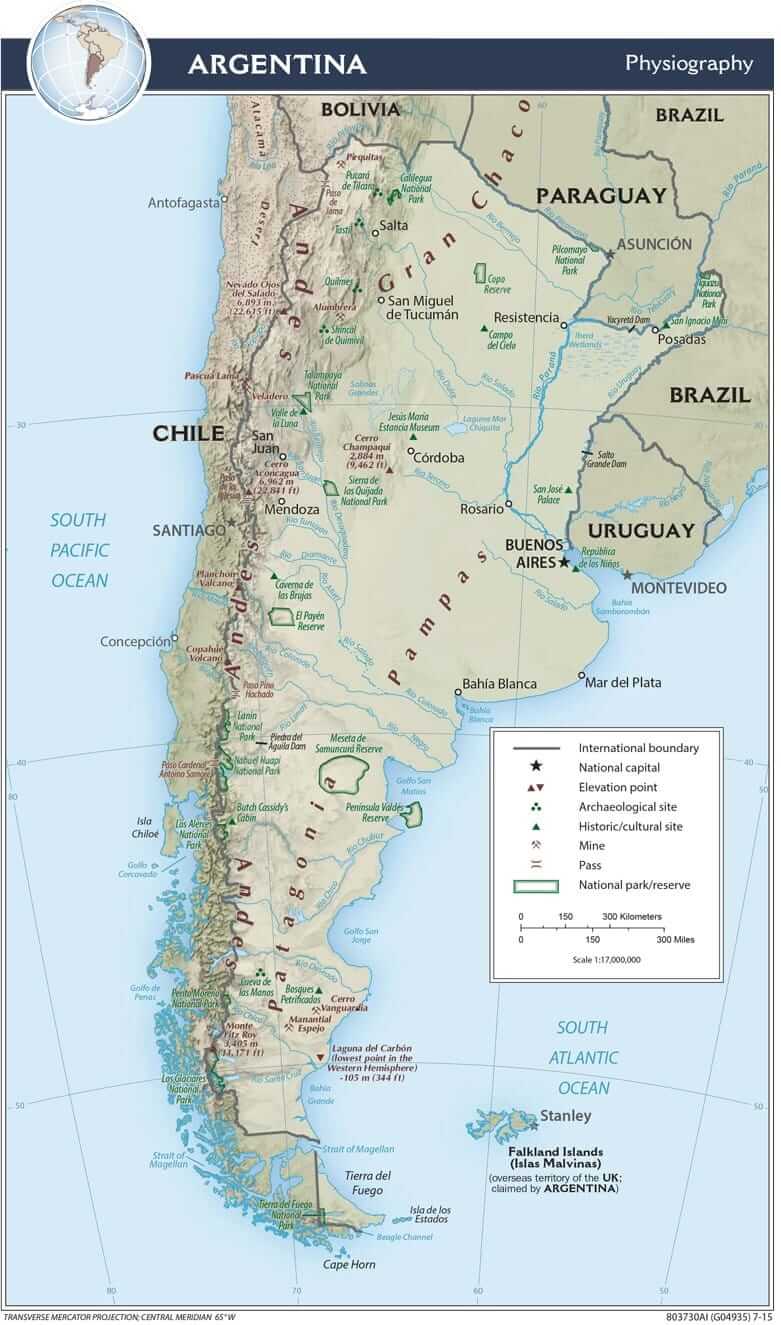
Argentina physiographic map.
Major Cities and Metropolitan Areas
Greater Buenos Aires (Population: ~15.7 million)
Argentina's capital and largest metropolitan area, Greater Buenos Aires, dominates the country's cultural, economic, and political life. The city is home to the majority of Argentina's cultural institutions, including world-class museums such as the Museo Nacional de Bellas Artes and the Teatro Colón, one of the world's great opera houses, as well as numerous theaters, galleries, and cultural centers. Buenos Aires is renowned for its European-inspired architecture, vibrant neighborhood culture, and sophisticated urban lifestyle. The city's cultural identity reflects its role as the entry point for European immigration, the birthplace of tango, and the center of Argentine intellectual and artistic life. Each neighborhood (barrio) maintains distinct cultural characteristics, from the historic colonial center to the bohemian La Boca to the elegant Recoleta.
Greater Córdoba (Population: ~1.6 million)
Argentina's second-largest city, Córdoba, serves as the cultural and educational center of the interior. Known for its colonial architecture and seven universities, Córdoba maintains strong traditions in education, religion, and regional culture. The city's cultural identity reflects its colonial heritage as an important administrative and religious center, its role in Argentina's independence movement, and its contemporary position as a center for technology and the automotive industries. Córdoba's cultural offerings include preserved colonial buildings, museums, festivals, and a vibrant student culture.
Greater Rosario (Population: ~1.4 million)
Located on the Paraná River, Rosario serves as Argentina's third-largest city and an important cultural center. The city is renowned for its progressive politics, rich architectural heritage, and vibrant cultural institutions. Rosario's identity reflects its role as a major port, its industrial heritage, and its reputation for political activism. The city has produced notable cultural figures and maintains active theater, music, and visual arts scenes. Rosario's riverfront development and cultural facilities make it a significant regional cultural hub.
Greater Mendoza (Population: ~1.1 million)
The center of Argentina's wine industry, Mendoza, combines agricultural traditions with sophisticated urban culture. The city's cultural identity centers on wine production, Andean geography, and connections to Chilean culture across the mountains. Mendoza hosts international wine festivals, maintains cultural institutions that celebrate regional heritage, and serves as a gateway to Andean tourism. The city's cultural life reflects both traditional Argentine elements and international influences brought by the development of the wine industry.
Greater Tucumán (Population: ~868,000)
Known as the "Garden of the Republic," San Miguel de Tucumán serves as the cultural center of northwest Argentina. The city's identity reflects its role in Argentine independence (the independence declaration was signed here in 1816), its colonial heritage, and its position as a center for sugar production and regional culture. Tucumán maintains strong traditions in folk music, crafts, and regional cuisine while serving as an educational and cultural center for the northwest region.
La Plata (Population: ~836,000)
Planned as the capital of Buenos Aires Province, La Plata represents 19th-century urban planning ideals and serves as an important educational center. The city's cultural identity is shaped by its role as a planned city, its major university, Universidad Nacional de La Plata, and its numerous museums and cultural institutions. La Plata's Museum of Natural Sciences is one of South America's most important, while the city's planned layout and architecture represent Argentine aspirations for modern urban development.
Mar del Plata (Population: ~710,000)
Argentina's premier beach resort city, Mar del Plata, represents seaside culture and domestic tourism traditions. The city's cultural identity centers on its role as a vacation destination for residents of Buenos Aires, its thriving casino and entertainment industry, and its position as a hub for the Argentine film industry. Mar del Plata hosts the International Film Festival and maintains cultural facilities that serve both residents and tourists.
Salta (Population: ~625,000)
Known as "Salta la Linda" (Salta the Beautiful), this northwestern city maintains strong colonial architecture and regional cultural traditions. Salta's cultural identity reflects its colonial heritage, its role as a center for northwest Argentine culture, and its position as a gateway to Andean tourism. The city maintains traditions in folk music, crafts, and regional cuisine, while preserving colonial architecture and hosting cultural festivals that celebrate its rich regional heritage.
Santa Fe (Population: ~530,000)
The capital of Santa Fe Province, this city serves as an important regional center with a strong colonial heritage. Santa Fe's cultural identity reflects its role in Argentine constitutional history, as two national constitutions were drafted here, its colonial architecture, and its position as a center for the Litoral region's culture. The city maintains cultural institutions that preserve regional history and traditions.
San Juan (Population: ~513,000)
San Juan is the capital and largest city of San Juan Province in western Argentina, located in the fertile Tulúm Valley at the foothills of the Andes Mountains. Known for its modern layout with wide, tree-lined avenues, the city was extensively rebuilt after a devastating earthquake in 1944, giving it a distinctly contemporary character amidst the region's arid landscapes. San Juan is a principal hub for Argentina's wine industry—especially famous for Malbec and Syrah—and serves as a gateway for adventure tourism.
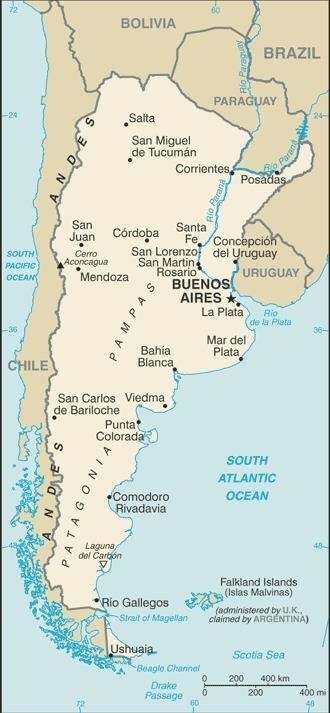
Map of Argentina with its most prominent cities.
Administrative Divisions of Argentina
Argentina is organized into 23 provinces plus the Autonomous City of Buenos Aires (Ciudad Autónoma de Buenos Aires). This federal system reflects the country's size, regional diversity, and historical development patterns.
Buenos Aires Province
Capital: La Plata
Population: ~17.5 million
Argentina's most populous province surrounds but does not include the federal capital. The province encompasses diverse cultural regions, from the industrial suburbs of Greater Buenos Aires to agricultural areas, coastal resorts, and rural towns. Cultural identity varies significantly across the province, from cosmopolitan suburban areas influenced by Buenos Aires to rural areas maintaining gaucho traditions and agricultural heritage. The province features important cultural sites, such as Luján, a Catholic pilgrimage center, and numerous historic estancias (ranches) that preserve the gaucho culture.
City of Buenos Aires (CABA)
Population: ~3.0 million
Argentina's federal capital and cultural center, the Autonomous City of Buenos Aires, concentrates the nation's political, economic, and cultural institutions. The city's cultural identity reflects its role as the entry point for European immigration, the birthplace of tango, and the center of Argentine intellectual life. Each neighborhood maintains distinct cultural characteristics, from the historic San Telmo to the modern Puerto Madero. The city is home to major cultural institutions, including Teatro Colón, numerous museums, universities, and cultural centers.
Córdoba Province
Capital: Córdoba
Population: ~3.8 million
Located in central Argentina, Córdoba Province combines colonial heritage with modern industrial development. The province's cultural identity reflects its role as an early colonial center, its numerous universities, and its position as a major industrial center. The province maintains strong traditions in education, colonial architecture, and regional folk culture while embracing modern technology and the automotive industries.
Santa Fe Province
Capital: Santa Fe
Population: ~3.4 million
This central province includes the major port city of Rosario and maintains strong agricultural and industrial traditions. The province's cultural identity reflects its role in Argentine agriculture, its major river ports, and its tradition of progressive politics. Santa Fe has made significant contributions to Argentine political and cultural development, with both the capital city and Rosario serving as important cultural centers.
Mendoza Province
Capital: Mendoza
Population: ~2.0 million
Located in western Argentina at the foothills of the Andes, Mendoza Province is the center of Argentine wine production. The province's cultural identity centers on viticulture, Andean geography, and connections to Chilean culture. Mendoza has developed sophisticated wine tourism, maintains cultural institutions celebrating regional heritage, and serves as a gateway to Andean recreation and tourism.
Tucumán Province
Capital: San Miguel de Tucumán
Population: ~1.7 million
Argentina's smallest province by area but historically significant, Tucumán, is known as the birthplace of Argentine independence. The province's cultural identity reflects its role in independence movements, its colonial heritage, and its position as the center of sugar production in the region. Tucumán maintains strong traditions in folk music, crafts, and regional cuisine.
Entre Ríos Province
Capital: Paraná
Population: ~1.4 million
Located between the Paraná and Uruguay rivers, Entre Ríos maintains strong traditions in agriculture and river culture. The province's cultural identity reflects its role in Argentine federation struggles, its gaucho heritage, and its river-based economy. The province maintains cultural connections to both Argentine Litoral culture and Uruguayan influences on the other side of the river.
Salta Province
Capital: Salta
Population: ~1.4 million
Located in northwest Argentina, Salta Province boasts a strong Indigenous heritage and rich colonial traditions. The province's cultural identity is shaped by significant Indigenous populations, particularly the Quechua and other Andean peoples, as well as colonial architecture and folk culture traditions. Salta serves as a cultural center for northwest Argentina and a gateway to Andean tourism.
Misiones Province
Capital: Posadas
Population: ~1.3 million
Located in northeast Argentina, Misiones Province borders Brazil and Paraguay, resulting in a unique cultural blend. The Guaraní Indigenous heritage, the history of the Jesuit mission, and contemporary immigration from neighboring countries shape the province's cultural identity. The province maintains the Iguazu Falls (shared with Brazil) and preserves Atlantic Forest ecosystems while developing eco-tourism and forestry industries.
Chaco Province
Capital: Resistencia
Population: ~1.2 million
Located in northern Argentina, Chaco Province maintains significant Indigenous populations and agricultural traditions. The province's cultural identity is reflected in its Indigenous heritage, particularly among the Qom, Moqoit, and Wichí peoples, as well as its tradition of cotton production and adaptation to a subtropical climate. Resistencia is known for its sculpture and public art, earning recognition as a center for artistic expression.
San Juan Province
Capital: San Juan
Population: ~780,000
Located in western Argentina, San Juan Province is a region that combines mining, agriculture, and wine production. The province's cultural identity reflects its role in Argentine independence movements, its adaptation to desert conditions, and its development of wine and agricultural industries. San Juan maintains cultural institutions that preserve regional history and traditions while embracing modern development.
Jujuy Province
Capital: San Salvador de Jujuy
Population: ~770,000
Argentina's northernmost province, Jujuy, maintains the strongest Indigenous cultural presence in the country. The province's cultural identity is shaped by significant Quechua and Aymara populations, Andean cultural traditions, and its connections to Bolivian culture. Jujuy preserves Indigenous languages, crafts, and festivals while developing tourism based on Andean landscapes and cultural heritage.
Santiago del Estero Province
Capital: Santiago del Estero
Population: ~750,000
One of Argentina's oldest provinces, Santiago del Estero, maintains a strong colonial heritage and folk culture traditions. The province's cultural identity is shaped by its role as an early Spanish settlement, its preservation of folk music traditions, particularly the chacarera, and its agricultural heritage. The province serves as a center for Argentine folk culture and traditional crafts.
Corrientes Province
Capital: Corrientes
Population: ~1.1 million
Located in northeast Argentina, Corrientes Province maintains a strong Guaraní cultural influence and river culture traditions. The province's cultural identity is reflected in the preservation of the Guaraní language, which is co-official with Spanish, as well as in its folk music traditions, particularly chamamé, and its cultural connections to Paraguay and southern Brazil. The province maintains unique cultural traditions, including carnival celebrations and religious festivals.
Formosa Province
Capital: Formosa
Population: ~600,000
Located in northern Argentina, Formosa Province borders Paraguay and has a significant Indigenous population. The province's cultural identity reflects Indigenous heritage, subtropical agriculture, and cultural connections to Paraguay. Formosa faces challenges related to economic development while preserving Indigenous cultures and environmental resources.
Neuquén Province
Capital: Neuquén
Population: ~650,000
Located in northern Patagonia, Neuquén Province combines energy production (oil and hydroelectric) with agricultural development. The province's cultural identity is shaped by its role in Argentine energy production, its Mapuche heritage, and its position as a gateway to Patagonian tourism. Neuquén has developed cultural institutions that address both regional heritage and contemporary development challenges.
Río Negro Province
Capital: Viedma
Population: ~720,000
Located in northern Patagonia, Río Negro Province encompasses a diverse range of landscapes, from the Andean regions to the Atlantic coast. The province's cultural identity is shaped by its role in fruit production, particularly apples and pears, its tourism industry centered on Bariloche, and its Patagonian heritage. The province maintains cultural institutions that celebrate both European immigration heritage and Patagonian traditions.
Chubut Province
Capital: Rawson
Population: ~620,000
Located in central Patagonia, Chubut Province boasts a unique Welsh immigration heritage, complemented by Patagonian traditions. The province's cultural identity is shaped by Welsh settlement in the Chubut Valley, its sheep ranching heritage, and coastal fishing traditions. The province preserves Welsh language and cultural traditions while embracing Patagonian identity and eco-tourism development.
Santa Cruz Province
Capital: Río Gallegos
Population: ~370,000
Located in southern Patagonia, Santa Cruz Province encompasses vast landscapes and a sparse population. The province's cultural identity reflects sheep ranching heritage, oil industry development, and adaptation to extreme southern conditions. The province maintains cultural institutions that preserve Patagonian traditions while addressing contemporary economic and environmental challenges.
Tierra del Fuego, Antártida e Islas del Atlántico Sur Province
Capital: Ushuaia
Population: ~170,000
Argentina's southernmost province encompasses Tierra del Fuego Island and includes territorial claims to Antarctica and the South Atlantic islands. The province's cultural identity reflects its position as the "end of the world," its maritime heritage, and its role in Antarctic research. Ushuaia serves as a tourist gateway while maintaining cultural institutions that address both local heritage and international connections.
La Rioja Province
Capital: La Rioja
Population: ~400,000
Located in northwest Argentina, La Rioja Province boasts a rich colonial heritage and vibrant regional traditions. The province's cultural identity reflects its role in Argentine independence movements, its adaptation to desert conditions, and its preservation of folk culture traditions. La Rioja maintains cultural institutions that celebrate regional heritage while addressing contemporary development challenges.
Catamarca Province
Capital: San Fernando del Valle de Catamarca
Population: ~420,000
Located in northwest Argentina, Catamarca Province maintains Indigenous heritage and traditional crafts. Significant Indigenous influence, a complex colonial history, and traditional textile and pottery production shape the province's cultural identity. Catamarca preserves traditional crafts and festivals while developing mining industries and tourism.
San Luis Province
Capital: San Luis
Population: ~510,000
Located in central Argentina, San Luis Province combines traditional agricultural practices with modern technological advancements. The province's cultural identity reflects its rural heritage, its recent emphasis on technology and education, and its position between traditional Argentine regions. San Luis has invested in education and technology while maintaining cultural connections to rural traditions.
La Pampa Province
Capital: Santa Rosa
Population: ~360,000
Located in central Argentina, La Pampa Province represents the heart of Argentine gaucho and agricultural traditions. The province's cultural identity centers on cattle ranching, agricultural production, and the preservation of gaucho culture. La Pampa maintains cultural institutions that celebrate rural heritage while addressing contemporary agricultural and environmental challenges.
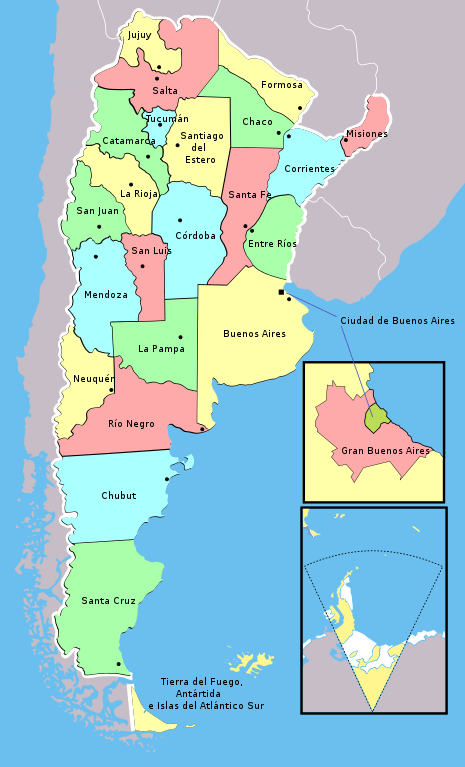
Political map of Argentina's provinces.
Argentina's Geographic Regions and Associated Provinces
Argentina, the eighth-largest country in the world by land area, encompasses an extraordinary diversity of landscapes, climates, and ecosystems across its vast territory of nearly 2.8 million square kilometers. This geographic diversity has shaped the nation's cultural identity, economic development, and regional characteristics. Argentina is traditionally divided into six major geographic regions, each with distinct topographical features, climate patterns, and provincial boundaries that reflect both natural geography and administrative organization.
The Pampas Region
The Pampas, Argentina's most economically significant region, forms the agricultural and demographic heart of the nation. This fertile plain extends across the provinces of Buenos Aires, much of Córdoba, Santa Fe, Entre Ríos, and La Pampa. The region's remarkably flat terrain, enriched by centuries of sediment deposits, creates some of the world's most productive agricultural land. The temperate climate, characterized by moderate rainfall and mild temperatures, supports extensive cattle ranching and grain production, particularly of wheat, corn, and soybeans.
Buenos Aires Province, the largest and most populous province in Argentina, dominates this region and houses nearly 40% of the country's population. The federal capital, Buenos Aires, sits at the region's eastern edge along the Río de la Plata. Santa Fe Province contributes significantly to agricultural output, while Córdoba Province serves as an important industrial center. Entre Ríos, positioned between the Paraná and Uruguay rivers, benefits from abundant water resources, and La Pampa Province extends the fertile plains westward toward Patagonia.
The Northwestern Region (NOA)
The Northwestern region encompasses the provinces of Jujuy, Salta, Tucumán, Santiago del Estero, Catamarca, and La Rioja. This area represents Argentina's most culturally diverse region, where Andean Indigenous traditions blend with colonial Spanish influences. The geography varies dramatically from the high-altitude Puna plateau in the west, reaching elevations over 4,000 meters, to the subtropical Yungas cloud forests on the eastern slopes of the Andes.
The region's economy is traditionally centered on sugar production in Tucumán, mining in Catamarca and La Rioja, and agriculture in the fertile valleys. Salta and Jujuy provinces showcase stunning mountain landscapes and preserve significant Indigenous cultural heritage. Santiago del Estero, one of Argentina's oldest provinces, maintains strong folkloric traditions while adapting to modern agricultural practices.
The Northeastern Region (NEA)
The Northeastern region includes the provinces of Misiones, Corrientes, Chaco, and Formosa. This subtropical region is characterized by abundant rainfall, high humidity, and lush vegetation. The Mesopotamia area, formed by the Paraná and Uruguay rivers, creates a unique ecosystem that supports a diverse flora and fauna.
Misiones Province, bordering Brazil and Paraguay, contains portions of the Atlantic Forest and houses the spectacular Iguazu Falls. The province's red soil supports the cultivation of yerba mate, tea production, and forestry. Corrientes Province, known for its wetlands and esteros (marshlands), maintains strong gaucho traditions and serves as a center for cattle ranching. Chaco and Formosa provinces feature vast lowlands with a mix of subtropical forests, savannas, and agricultural areas, though they face challenges related to deforestation and economic development.
Cuyo Region
The Cuyo region comprises the provinces of Mendoza, San Juan, and San Luis, located in the western part of Argentina, along the foothills of the Andes. This semi-arid region is renowned for its wine production, particularly in Mendoza Province, which accounts for approximately 70% of Argentina's wine output. The region's geography features dramatic contrasts between the high Andes peaks, including Aconcagua (the highest mountain in the Western Hemisphere), and the desert valleys below.
Mendoza Province benefits from snowmelt irrigation systems that enable intensive agriculture in an otherwise arid environment. San Juan Province specializes in grape and olive production, while also featuring significant mining operations. San Luis Province, situated at the eastern edge of the region, serves as a transitional zone between the Andes and the Pampas, with a growing industrial sector supported by favorable tax policies.
Patagonia Region
Patagonia, Argentina's largest region by area, encompasses the provinces of Neuquén, Río Negro, Chubut, Santa Cruz, and Tierra del Fuego. This vast territory stretches from the Colorado River in the north to Cape Horn in the south, covering approximately one-third of Argentina's total area despite containing less than 5% of its population.
The region's geography features the Andes Mountains along its western border, characterized by glacial lakes, temperate forests, and snow-capped peaks. The eastern portion consists of vast steppes and plateaus characterized by arid to semi-arid conditions. Neuquén and Río Negro provinces in northern Patagonia support fruit production, particularly apples and pears, as well as emerging oil and natural gas industries. Chubut Province is famous for its Welsh settlements and the Peninsula Valdés wildlife sanctuary. Santa Cruz Province features extensive sheep ranching operations and significant oil reserves, while Tierra del Fuego, the southernmost province, is characterized by harsh climate conditions and unique subantarctic ecosystems.
Central Region
The Central region, sometimes considered part of the broader Pampas classification, includes Córdoba Province and portions of surrounding areas that serve as transitional zones between major regions. Córdoba city, Argentina's second-largest urban center, functions as an important industrial and educational hub. The province boasts a diverse geography, ranging from plains suitable for agriculture to mountain ranges that attract tourists.
This regional diversity has profoundly influenced Argentina's development patterns, with the fertile Pampas supporting the majority of the population and economic activity, while the peripheral regions contribute specialized products and maintain distinct cultural identities. The geographic contrasts between regions continue to shape Argentina's political dynamics, economic policies, and cultural expressions, making the country one of South America's most geographically and culturally complex nations.
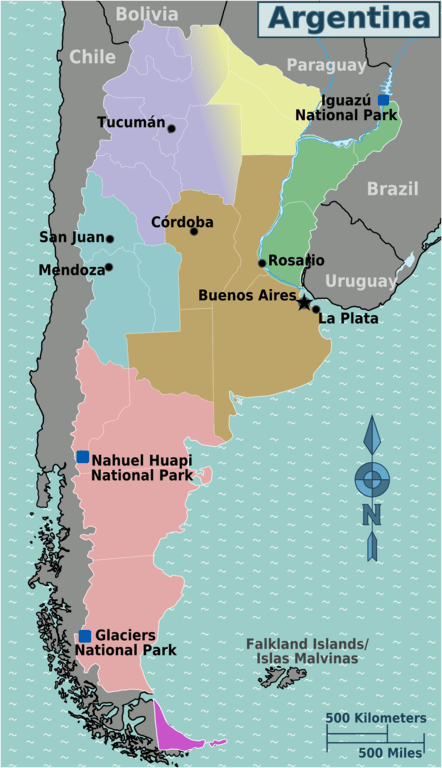
Map illustrating the geopolitical zones of Argentina.
Historical, Cultural, and Natural Landmarks by Region
The Pampas Region
Buenos Aires Province
Historical Landmarks: The colonial heritage of Buenos Aires centers around the Cabildo of Buenos Aires. This meticulously preserved government building now serves as a museum chronicling the city's political evolution. Plaza de Mayo represents Argentina's most significant historical square, witnessing countless political demonstrations and national celebrations throughout the centuries. The iconic Casa Rosada, with its distinctive pink facade, has served as the presidential palace and remains the seat of executive power. Recoleta Cemetery serves as the final resting place for Eva Perón and numerous other notable Argentine figures, with its elaborate mausoleums reflecting the nation's complex social history. La Boca neighborhood preserves the authentic atmosphere of early 20th-century immigrant quarters, particularly the Italian community that shaped much of Buenos Aires' cultural identity.
Cultural Landmarks: Teatro Colón stands as one of the world's premier opera houses, hosting international performances and maintaining Argentina's reputation as a cultural center of South America. San Telmo neighborhood embodies the heart of tango culture, featuring cobblestone streets, antique markets, and traditional milongas where locals and visitors experience authentic Argentine dance. Café Tortoni, operating continuously since 1858, represents Buenos Aires' café culture and has hosted literary gatherings, political discussions, and cultural events for over a century. Barrio Norte showcases French-influenced architecture from Argentina's Belle Époque period, demonstrating the country's European cultural connections. Puerto Madero transforms former docklands into a modern cultural district, housing contemporary art centers, restaurants, and cultural spaces that bridge Argentina's past and present.
Natural Landmarks: The massive Río de la Plata estuary dominates Buenos Aires' eastern boundary, creating unique ecosystems where fresh and salt water merge. Costanera Sur Ecological Reserve provides an unexpected urban nature preserve, allowing native species to flourish within sight of downtown skyscrapers. Delta del Tigre features extensive wetland systems located north of Buenos Aires, which support a diverse array of wildlife and traditional river culture. Mar del Plata beaches extend along the Atlantic coast, providing Argentina's premier seaside resort destination. Sierra de la Ventana rises from the southern pampas, offering the only significant elevation in Buenos Aires Province and supporting unique plant communities adapted to the region's climate.
Córdoba Province
Historical Landmarks: The Jesuit Block and Estancias represent a UNESCO World Heritage colonial complex that showcases the profound impact of Jesuit missions on Argentine education and culture. Córdoba Cathedral exemplifies baroque colonial architecture and serves as the spiritual center of Argentina's oldest inland city. Alta Gracia Jesuit Estancia preserves the colonial estate where Che Guevara spent his childhood, offering insight into both the religious and colonial history of the era, as well as his revolutionary biography. The Cabildo of Córdoba remains a symbol of colonial governance and early independence movements in the interior provinces.
Cultural Landmarks: The Universidad Nacional de Córdoba, founded in 1613, ranks among the oldest universities in the Americas and continues to have a profound influence on Argentine intellectual life. Paseo del Buen Pastor transforms a former women's prison into a dynamic cultural center, housing theaters, galleries, and performance spaces. Córdoba's cuarteto music venues celebrate the region's distinctive musical tradition, blending folk elements with contemporary rhythms in neighborhood clubs and festival settings.
Natural Landmarks: The Sierras de Córdoba provide Argentina's most accessible mountain recreation, offering hiking, climbing, and scenic drives within reach of major population centers. Los Gigantes present dramatic granite formations that challenge rock climbers and provide spectacular photographic opportunities. Quebrada del Condorito National Park protects high-altitude grasslands and serves as a crucial sanctuary for Andean condors, allowing visitors to observe these magnificent birds in their natural habitat.
Santa Fe Province
Historical Landmarks: Santa Fe la Vieja Archaeological Site preserves the remains of the original colonial settlement, demonstrating early Spanish urban planning and construction techniques. Cayastá ruins offer archaeological evidence of the daily life of the first Santa Fe settlement, including the foundations of houses, churches, and public buildings. Rosario's Flag Memorial commemorates Manuel Belgrano's creation of the Argentine flag, marking a pivotal moment in the nation's struggle for independence.
Cultural Landmarks: Rosario's cultural district is home to museums, theaters, and art galleries in a walkable area that celebrates the city's role as Argentina's third-largest urban center. Santa Fe's colonial architecture remains remarkably well-preserved, showcasing Spanish colonial building techniques that were adapted to the region's climate and local materials.
Natural Landmarks: Paraná River islands create complex wetland ecosystems that support diverse bird populations and traditional fishing communities. El Palmar National Park, shared with Entre Ríos Province, preserves extensive groves of yatay palms, protecting this unique ecosystem from agricultural conversion.
Entre Ríos Province
Historical Landmarks: Palacio San José preserves the historic residence of President Justo José de Urquiza, offering insights into 19th-century Argentine political life and architectural preferences. Concepción del Uruguay's historic center maintains well-preserved colonial architecture that reflects the city's importance during the colonial period and the early independence era.
Cultural Landmarks: Gualeguaychú Carnival represents one of South America's most vibrant annual celebrations, attracting visitors from across the continent with elaborate costumes, music, and dancing. Colón's cultural festivals celebrate traditional music and arts throughout the year, maintaining regional cultural traditions while attracting contemporary artists and performers.
Natural Landmarks: El Palmar National Park protects ancient yatay palm forests, preserving ecosystems that once covered much larger areas of the Mesopotamia region. The Paraná River delta is home to extensive wetland systems that support a diverse array of migratory birds and endemic species. Uruguay River hot springs provide natural thermal water resorts, combining relaxation with scenic river valley settings.
La Pampa Province
Historical Landmarks: Lihuel Calel petroglyphs preserve ancient Indigenous rock art, providing evidence of pre-Columbian cultures that inhabited the pampas region. General Acha's historic buildings represent frontier town architecture from Argentina's westward expansion period, showcasing adaptation to harsh environmental conditions.
Natural Landmarks: Lihuel Calel National Park protects low hills and native wildlife in an otherwise flat landscape, serving as an important refuge for pampas species. Salinas Grandes creates large salt flat formations that support specialized plant and animal communities. Caldén forest reserves preserve native woodland areas that once covered much larger portions of the western pampas.
Northwestern Region (NOA)
Jujuy Province
Historical Landmarks: Pucará de Tilcara preserves extensive pre-Columbian fortress ruins, demonstrating sophisticated Indigenous urban planning and defensive architecture. The Cabildo of Jujuy represents colonial government architecture adapted to high-altitude conditions and local building materials. The Church of Yavi showcases colonial religious architecture with remarkable gold-leaf interior decorations, reflecting the region's mining wealth and Spanish artistic influence.
Cultural Landmarks: Humahuaca's Quebrada represents a UNESCO World Heritage cultural landscape where Indigenous, Spanish, and contemporary cultures blend in spectacular mountain valley settings. Traditional Indigenous villages throughout the province maintain authentic Andean communities, preserving languages, customs, and agricultural practices that predate the arrival of the Spanish. Carnival celebrations in Tilcara and Humahuaca demonstrate the region's vibrant cultural synthesis, combining Indigenous traditions with Spanish colonial and contemporary influences.
Natural Landmarks: The Quebrada de Humahuaca creates a dramatic multicolored valley where geological formations display millions of years of sedimentary history in spectacular visual layers. Salinas Grandes form spectacular high-altitude salt flats that create otherworldly landscapes at over 3,000 meters of elevation. Calilegua National Park preserves unique cloud forest ecosystems on the eastern slopes of the Andes, protecting biodiversity that exists nowhere else in Argentina. Cerro de los Siete Colores features a seven-colored mountain formation that has become an iconic symbol of the geological diversity of northwestern Argentina.
Salta Province
Historical Landmarks: Salta Cathedral and the surrounding historic center preserve exceptionally well-maintained colonial architecture, earning the city recognition as one of South America's best-preserved colonial urban centers. The Train to the Clouds railway represents both a historic engineering achievement and a contemporary tourist attraction, reaching altitudes over 4,000 meters through spectacular Andean landscapes. Cachi stands as a perfectly preserved colonial town, with traditional adobe architecture and cobblestone streets set in a dramatic mountain valley. Cafayate archaeological sites preserve pre-Columbian ruins and petroglyphs that predate Spanish colonization by centuries.
Cultural Landmarks: Salta folk music venues serve as centers for traditional Andean music, where chacarera, zamba, and other regional musical forms continue to evolve while maintaining their cultural roots. Molinos historic village preserves adobe architecture and traditional crafts, demonstrating how Indigenous and Spanish building techniques merged in high-altitude environments. Traditional weaving communities throughout the province maintain Indigenous textile production techniques, creating ponchos, blankets, and clothing using methods passed down through generations.
Natural Landmarks: Los Cardones National Park protects extensive giant cactus forests, preserving unique high-altitude desert ecosystems dominated by massive cardón cacti. Cafayate wine valley combines high-altitude vineyards with dramatic red rock landscapes, creating one of Argentina's most scenic wine-producing regions. Tolar Grande represents a remote, high-altitude salt desert environment that supports specialized plant and animal communities adapted to extreme conditions. Iruya mountain village provides access to spectacular Andean settings where traditional architecture harmonizes with dramatic natural landscapes.
Tucumán Province
Historical Landmarks: Casa Histórica de la Independencia preserves the exact location where Argentine independence was declared in 1816, maintaining the building's colonial architecture and historical significance as a national shrine. Quilmes ruins protect extensive pre-Columbian settlement remains, demonstrating sophisticated Indigenous urban planning and defensive architecture from the pre-Spanish period. San Miguel de Tucumán's colonial architecture reflects the city's role as a major colonial administrative center and its continued importance in northwestern Argentina.
Cultural Landmarks: Traditional sugar mill museums preserve Argentina's industrial heritage, showcasing how sugar production significantly influenced the regional economy and culture from colonial times to the 20th century. Folk music festivals celebrate regional traditions, preserving chacarera, zamba, and other musical forms that express the cultural identity of northwestern Argentina.
Natural Landmarks: Aconquija National Park protects mountain wilderness areas, preserving high-altitude ecosystems and providing habitat for endangered species. Yungas cloud forests create unique subtropical mountain forest environments on the eastern slopes of the Andes, supporting biodiversity found nowhere else in Argentina. El Cadillal reservoir provides mountain lake recreation opportunities while supporting regional water supplies and hydroelectric generation.
Santiago del Estero Province
Historical Landmarks: Santiago del Estero Cathedral claims recognition as Argentina's oldest cathedral, reflecting the city's status as the country's oldest continuously inhabited Spanish settlement. Thermas de Río Hondo developed as a historic thermal spa town, attracting visitors seeking therapeutic benefits from natural hot springs since the early 20th century.
Cultural Landmarks: Chacarera music venues celebrate the province's role as the birthplace of this distinctive Argentine folk music style, maintaining traditional performance spaces and annual festivals. Traditional craft centers preserve pottery and textile production techniques that blend Indigenous and Spanish colonial methods, creating distinctive regional artistic expressions.
Natural Landmarks: Copo National Park preserves dry forest ecosystems, protecting quebracho forests and associated wildlife communities that once covered much larger areas of the Chaco region. Dulce River wetlands provide important bird habitat, supporting migratory species and serving as breeding grounds for waterfowl. The Salado River basin generates seasonal wetland systems that support a diverse array of wildlife during flood periods, while showcasing natural cycles that have shaped the regional ecology for millennia.
Catamarca Province
Historical Landmarks: Pucará del Aconquija preserves pre-Columbian fortress ruins, demonstrating Indigenous defensive architecture and settlement patterns that predate Spanish colonization. Shincal archaeological site protects the ruins of an Inca administrative center, representing the southernmost extension of Inca influence in South America. Colonial churches in Belén and Londres showcase Spanish religious architecture adapted to high-altitude desert conditions and local building materials.
Cultural Landmarks: Traditional poncho weaving centers in Catamarca maintain the region's reputation for producing Argentina's finest ponchos, utilizing techniques and designs that have been refined over centuries. Indigenous festivals and ceremonies preserve authentic cultural celebrations, maintaining connections to pre-Columbian traditions while adapting to contemporary contexts.
Natural Landmarks: Antofagasta de la Sierra boasts high-altitude volcanic landscapes, characterized by active volcanic activity, mineral deposits, and specialized ecosystems that are uniquely adapted to the extreme elevation and arid conditions. Campo de Piedra Pómez creates spectacular pumice stone formations, demonstrating volcanic geological processes in accessible and photographically stunning settings. Fiambalá hot springs offer natural thermal pools in a desert setting, combining therapeutic benefits with an otherworldly landscape experience.
La Rioja Province
Historical Landmarks: Santo Domingo Convent represents a historic religious complex, preserving colonial religious architecture and serving as a center for regional spiritual life. Chilecito mining heritage sites protect historic mining installations, demonstrating how mineral extraction shaped regional development from colonial times through the 20th century.
Cultural Landmarks: Traditional wine production centers maintain historic vineyards and bodegas, preserving winemaking techniques while adapting to contemporary market demands. Folk music festivals celebrate regional cultural traditions, preserving traditional musical forms while fostering contemporary artistic innovation.
Natural Landmarks: Talampaya National Park, designated as a UNESCO World Heritage site, protects spectacular red rock canyon systems formed by millions of years of erosion, creating dramatic landscapes and important paleontological sites. Valle de la Luna presents a dramatically eroded landscape that showcases geological processes while offering otherworldly scenic experiences. Laguna Brava serves as a high-altitude flamingo habitat, supporting large populations of flamingos and other water birds in remote Andean settings.
Northeastern Region (NEA)
Misiones Province
Historical Landmarks: San Ignacio Jesuit Mission ruins, designated as a UNESCO World Heritage site, preserve the most complete remains of Jesuit missions, demonstrating the complex interaction between Spanish colonial objectives and Indigenous communities. Loreto and Santa Ana mission ruins provide additional evidence of Jesuit settlement patterns, showcasing different approaches to mission architecture and community organization. Wanda gemstone mines represent historic mining operations, demonstrating how the region's geological wealth has been extracted and processed over the decades.
Cultural Landmarks: Guaraní cultural centers preserve Indigenous heritage, maintaining language, customs, and traditional knowledge that survived Spanish colonization and continues to influence regional culture. German and Polish immigrant settlements showcase European cultural heritage, illustrating how 20th-century immigration gave rise to distinct communities within the broader Argentine cultural landscape. Traditional yerba mate production facilities in Argentina preserve the cultivation and processing techniques for the country's national beverage, maintaining cultural practices that extend throughout South America.
Natural Landmarks: Iguazu Falls represents a UNESCO World Heritage spectacular waterfall system, featuring over 270 individual falls cascading through subtropical rainforest in one of South America's most dramatic natural displays. Iguazu National Park preserves extensive subtropical rainforest, protecting biodiversity and providing habitat for jaguars, toucans, and hundreds of other species. Moconá Falls creates a unique longitudinal waterfall formation where the Uruguay River flows over a geological fault, producing a waterfall that runs parallel to the river's flow. Atlantic Forest reserves protect remnants of an endangered ecosystem that once covered much larger areas of southeastern South America.
Corrientes Province
Historical Landmarks: Corrientes' colonial architecture preserves a remarkably well-maintained historic center, demonstrating Spanish colonial urban planning and architectural adaptation to subtropical climate conditions. Yapeyú holds significance as the birthplace of General José de San Martín, South America's greatest independence hero, with monuments and museums commemorating his early life. Mercedes' historic district combines colonial and 19th-century architecture, reflecting the city's evolution from colonial settlement to regional commercial center.
Cultural Landmarks: Chamamé music venues serve as traditional regional music centers, preserving and evolving a distinctive musical style that combines Indigenous, Spanish, and other cultural influences. Gaucho festivals and traditions preserve authentic rural cultural celebrations, showcasing horseman skills, traditional crafts, and the rural lifestyle that has defined much of Argentine cultural identity. Traditional craft production centers specialize in leather goods and textiles, maintaining techniques and designs that reflect both functional needs and aesthetic preferences developed over centuries.
Natural Landmarks: Iberá Wetlands create a vast marshland ecosystem and wildlife sanctuary, supporting caimans, capybaras, hundreds of bird species, and aquatic plants in one of South America's most important wetland systems. Mburucuyá National Park preserves savanna and forest ecosystems, protecting the transition zone between different ecological regions and providing habitat for a diverse array of wildlife. The islands of the Uruguay River support pristine river ecosystems, maintaining natural communities that demonstrate pre-European environmental conditions.
Chaco Province
Historical Landmarks: Resistencia sculpture park functions as an outdoor art museum, featuring over 600 sculptures that transform the city into one of the world's most extensive urban sculpture collections. Fontana's historic buildings preserve early 20th-century architecture, demonstrating how frontier settlements developed during Argentina's agricultural expansion period.
Cultural Landmarks: Indigenous cultural centers preserve the heritage sites of the Wichí, Toba, and Mocoví, maintaining their languages, customs, and traditional knowledge, which are passed down by multiple Indigenous groups inhabiting the Chaco region. Traditional craft markets showcase Indigenous art and handicrafts, providing economic opportunities while preserving cultural traditions that express Indigenous identity and worldview.
Natural Landmarks: Chaco National Park preserves dry forest and wetland ecosystems, protecting quebracho forests and associated wildlife in one of South America's most threatened ecological regions. Impenetrable National Park protects a dense forest wilderness, preserving intact ecosystems that support jaguars, peccaries, and other species that require extensive, undisturbed habitat. The Bermejo River basin offers crucial wetland habitat, supporting diverse fish populations, waterbirds, and riparian forests along one of northern Argentina's major rivers.
Formosa Province
Historical Landmarks: Formosa's historic center preserves early frontier town architecture, demonstrating how settlements developed along Argentina's northern border during the late 19th and early 20th centuries. Clorinda's border heritage sites mark the historical crossing point between Argentina and Paraguay, preserving buildings and monuments that reflect the region's significant role in international trade and migration.
Cultural Landmarks: Indigenous community centers preserve the heritage of multiple ethnic groups, maintaining the cultural traditions of numerous Indigenous communities that continue to inhabit the province. Traditional fishing culture sites celebrate river community traditions, preserving techniques and customs that have sustained communities along the Paraguay and Pilcomayo rivers for generations.
Natural Landmarks: Río Pilcomayo National Park protects wetland and palm forest ecosystems, preserving the complex ecological interactions between rivers, wetlands, and subtropical forests. Bañado La Estrella creates seasonal wetland systems that support diverse wildlife during flood periods, while demonstrating natural hydrological cycles. The Bermejo River wetlands are important biodiversity areas, supporting fish populations, waterbirds, and riparian vegetation along the province's major river system.
Cuyo Region
Mendoza Province
Historical Landmarks: General San Martín Park and monuments commemorate the location where the liberation army prepared for the crossing of the Andes, preserving the memory of South America's most important independence campaign. Aconcagua Provincial Park serves as a historic mountaineering destination, attracting climbers from around the world to attempt the highest peak in the Western Hemisphere. Historic bodegas preserve century-old wine production facilities, demonstrating how European winemaking techniques adapted to Argentine conditions and developed into world-class wine production.
Cultural Landmarks: The Mendoza wine route is a world-renowned viticulture region, blending scenic beauty with exceptional wine production in high-altitude desert valleys. The Harvest Festival (Fiesta de la Vendimia) is a major annual cultural celebration that combines wine harvest traditions with music, dance, and regional cultural expressions. Traditional Argentine asado culture reaches its pinnacle in Mendoza, where wine and grilled meat combine in authentic barbecue traditions that express Argentine culinary identity.
Natural Landmarks: Aconcagua rises to 6,962 meters as the highest peak in the Western Hemisphere, attracting mountaineers from around the world and serving as the ultimate challenge for high-altitude climbing in South America. Puente del Inca presents a natural rock bridge formation, created by mineral deposits from hot springs that have formed a spectacular geological arch over centuries. Las Leñas ski resort provides premier Andean winter sports destinations, offering world-class skiing and snowboarding in the heart of the Andes Mountains. The Uspallata Valley creates dramatic high-altitude desert landscapes, providing access to Aconcagua while showcasing the stark beauty of the Andean desert.
San Juan Province
Historical Landmarks: Difunta Correa shrine represents one of Argentina's most important religious pilgrimage sites, attracting hundreds of thousands of visitors annually who seek miraculous intervention from this folk saint. Historic earthquake reconstruction sites demonstrate the architecture of the 1944 earthquake recovery, showcasing how the city rebuilt itself using modern seismic-resistant construction techniques after devastating earthquake damage.
Cultural Landmarks: Traditional wine and olive production centers maintain regional specialties, preserving techniques that have adapted European agricultural methods to high-altitude desert conditions. Folk music festivals celebrate Cuyo regional traditions, maintaining musical forms that blend Spanish colonial influences with Indigenous and contemporary elements.
Natural Landmarks: Valle de la Luna (Moon Valley) serves as a UNESCO World Heritage paleontological site, preserving fossils that provide crucial evidence about dinosaur evolution and ancient ecosystems. Talampaya National Park, shared with La Rioja Province, protects spectacular red rock canyon formations created by millions of years of erosion and geological activity. El Leoncito National Park functions as a dark sky astronomical preserve, offering some of the clearest night skies in the world for astronomical observation and research. Mercedario National Park preserves high Andean mountain environments, protecting ecosystems adapted to extreme altitude and providing habitat for vicuñas and other high-altitude species.
San Luis Province
Historical Landmarks: San Luis colonial center maintains well-preserved historic architecture, demonstrating Spanish colonial urban planning adapted to the transition zone between the Andes and the Pampas. Potrero de los Funes preserves a historic lakeside settlement, showcasing how communities adapted to mountain lake environments while maintaining connections to broader regional culture.
Cultural Landmarks: Traditional gaucho festivals celebrate regional rural heritage, maintaining horseman traditions and rural skills that defined much of Argentine cultural identity. Artisan craft centers specialize in the production of local pottery and textiles, preserving techniques that reflect both functional needs and aesthetic preferences developed over generations.
Natural Landmarks: Sierra de las Quijadas National Park protects unique red rock desert landscapes, preserving paleontological sites and desert ecosystems while providing dramatic scenic experiences. Potrero de los Funes creates scenic mountain lake settings, offering recreation opportunities while supporting local tourism and preserving natural beauty. The Merlo mountain resort area boasts natural thermal spring regions, offering a unique blend of therapeutic benefits and stunning mountain scenery in easily accessible recreational settings.
Patagonia Region
Neuquén Province
Historical Landmarks: The Zapala paleontological sites preserve important dinosaur fossil discoveries, providing crucial evidence for understanding the evolution of dinosaurs and the ancient ecosystems of Patagonia. Rincón de los Sauces represents a significant archaeological and paleontological area, combining evidence of both prehistoric life and Indigenous human occupation in northern Patagonia.
Cultural Landmarks: Mapuche cultural centers preserve the Indigenous heritage of Patagonia's original inhabitants, maintaining their language, customs, and traditional knowledge. These centers continue to influence regional culture. Traditional sheep ranching culture demonstrates authentic Patagonian rural traditions, preserving the skills and lifestyle that have defined the region's economy and cultural identity for over a century.
Natural Landmarks: Lanín National Park preserves Araucaria forests and volcanic landscapes, protecting ancient monkey puzzle tree forests and active volcanic environments that create unique ecosystems. Nahuel Huapi National Park's northern section encompasses lake and forest ecosystems, extending Argentina's oldest national park into diverse environments that support both temperate forests and high-altitude grasslands. Copahue hot springs combine natural thermal pools with ski resort facilities, offering year-round recreation opportunities in dramatic volcanic settings. Laguna Blanca National Park protects high-altitude lakes and wildlife preserves, supporting flamingo populations and other waterfowl in pristine Patagonian steppe environments.
Río Negro Province
Historical Landmarks: Carmen de Patagones represents a historic frontier settlement, preserving Argentina's southernmost Spanish colonial architecture and demonstrating early attempts to establish permanent settlements in northern Patagonia. Viedma's historic center maintains provincial capital architecture, showcasing how administrative centers developed during Argentina's territorial expansion into Patagonia.
Cultural Landmarks: Welsh cultural heritage sites preserve 19th-century immigrant settlements, maintaining language, customs, and architectural styles brought by Welsh colonists who established unique communities in the Chubut River valley. Apple and pear production heritage creates agricultural cultural landscapes, demonstrating how European agricultural techniques adapted to Patagonian climate conditions while establishing major export industries.
Natural Landmarks: Nahuel Huapi National Park serves as Argentina's oldest national park, preserving pristine lakes, temperate forests, and mountain ecosystems that have become synonymous with Argentine natural beauty. The Bariloche lake district offers scenic alpine-style resort regions, blending natural beauty with recreational opportunities in settings that draw visitors from around the world. Peninsula Valdés extends into marine wildlife sanctuary areas from its northern tip, supporting marine mammal populations and serving as a gateway to one of South America's most important wildlife viewing destinations. Negro River valley creates important agricultural and wildlife corridors, supporting intensive fruit production while maintaining riparian ecosystems that provide habitat for diverse species.
Chubut Province
Historical Landmarks: Gaiman Welsh settlement preserves historic tea houses and museums, maintaining the cultural traditions of Welsh immigrants who established unique communities in Patagonian valleys during the 19th century. Trelew paleontological museum houses important fossil discoveries, showcasing Patagonia's rich paleontological heritage and contributing to global understanding of prehistoric life. Puerto Madryn's historic whaling stations preserve evidence of early industrial activity, demonstrating how marine resource exploitation shaped early Patagonian development.
Cultural Landmarks: Welsh cultural festivals, including the Eisteddfod and other traditional celebrations, maintain European cultural traditions adapted to Patagonian settings while contributing to Argentina's multicultural identity. Patagonian sheep ranching heritage preserves traditional estancia culture, maintaining the skills, architecture, and lifestyle that have defined rural Patagonia for generations.
Natural Landmarks: Peninsula Valdés represents a UNESCO World Heritage marine wildlife sanctuary, supporting southern right whales, elephant seals, sea lions, and penguins in one of South America's most important marine ecosystems. Punta Tombo hosts the world's largest continental penguin colony, providing critical breeding habitat for Magellanic penguins while offering exceptional wildlife viewing opportunities. Los Alerces National Park preserves an ancient forest with millenary trees, protecting some of South America's oldest living trees in pristine temperate rainforest environments. Perito Moreno Glacier's northern access points provide views of this famous advancing glacial formation, offering accessible opportunities to observe active glacial processes.
Santa Cruz Province
Historical Landmarks: Cueva de las Manos preserves UNESCO World Heritage prehistoric cave paintings, showcasing some of South America's oldest known rock art created by Indigenous peoples thousands of years ago. Puerto Deseado's historic buildings preserve early Patagonian port architecture, illustrating how coastal settlements evolved to support regional trade and resource extraction. El Calafate, a frontier town, preserves the heritage of settlements that developed to serve the regional sheep ranching economy and later adapted to cater to glacier tourism.
Cultural Landmarks: The traditional Patagonian estancia culture maintains an authentic sheep ranching heritage, preserving the skills, architecture, and social patterns that have defined rural Patagonia while adapting to contemporary economic conditions. Archaeological sites throughout the province feature Indigenous petroglyphs, providing evidence of the rich cultural traditions of Patagonia's original inhabitants.
Natural Landmarks: Los Glaciares National Park encompasses a UNESCO World Heritage glacial landscape, protecting extensive ice fields, glacial lakes, and mountain environments that represent some of South America's most spectacular natural scenery. Perito Moreno Glacier stands as the most famous advancing glacier, offering visitors the opportunity to observe active glacial processes, including dramatic icefalls and calving events. The Fitz Roy mountain range features dramatic granite peaks, drawing mountain climbers and photographers to some of the most challenging and visually stunning mountains in South America. Laguna de los Flamencos serves as a high-altitude flamingo habitat, supporting large populations of flamingos in remote Andean lake environments. Monte León National Park preserves coastal steppe and marine environments, protecting the interaction between land and sea ecosystems along Patagonia's Atlantic coast.
Tierra del Fuego Province
Historical Landmarks: Ushuaia's historic buildings represent the world's southernmost city architecture, preserving structures that demonstrate how communities adapted to extreme southern latitude conditions while maintaining connections to Argentine national culture. The End of the World Train preserves the historic prisoner railway, maintaining the narrow-gauge railway that once transported prisoners and supplies while providing contemporary visitors with access to pristine wilderness areas. Harberton Estancia functions as a historic ranch and museum, preserving the architecture and lifestyle of early sheep ranching operations while providing insights into the region's maritime and terrestrial natural history.
Cultural Landmarks: Yamana and Selk'nam Indigenous heritage sites preserve the cultural memory of Tierra del Fuego's original inhabitants, maintaining knowledge of maritime and terrestrial survival techniques adapted to subantarctic conditions. End-of-the-world cultural identity gives rise to unique frontier community traditions, blending isolation with cosmopolitan influences from international tourism and maritime activities.
Natural Landmarks: Tierra del Fuego National Park preserves subantarctic forest and coastal environments, protecting the unique ecosystems that develop under extreme southern latitude conditions while providing habitat for species found nowhere else in Argentina. Beagle Channel creates dramatic waterways between islands, supporting marine ecosystems while providing scenic boat travel opportunities through spectacular mountain and forest landscapes. Martial Glacier provides accessible glacial formations near Ushuaia, offering hiking opportunities to observe glacial processes within easy reach of urban facilities. Lapataia Bay marks the southernmost point of the Pan-American Highway, symbolizing the end of the world's longest road system while providing access to pristine coastal and forest environments. Cabo de Hornos (Cape Horn) represents the southernmost tip of South America, maintaining its reputation as one of the world's most challenging maritime passages while supporting unique subantarctic ecosystems.

